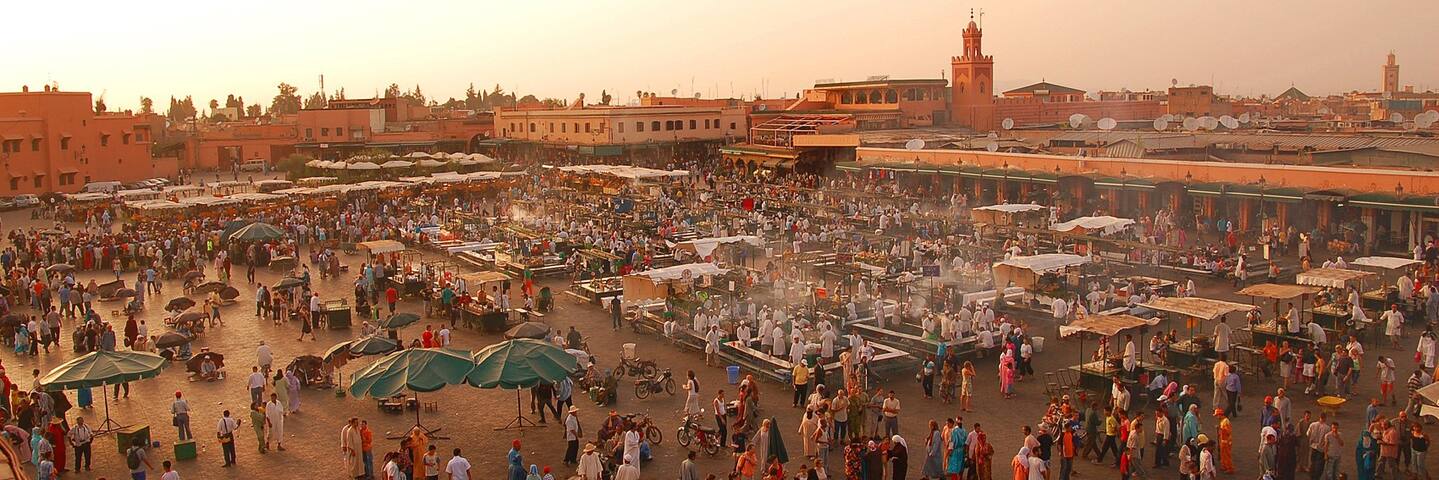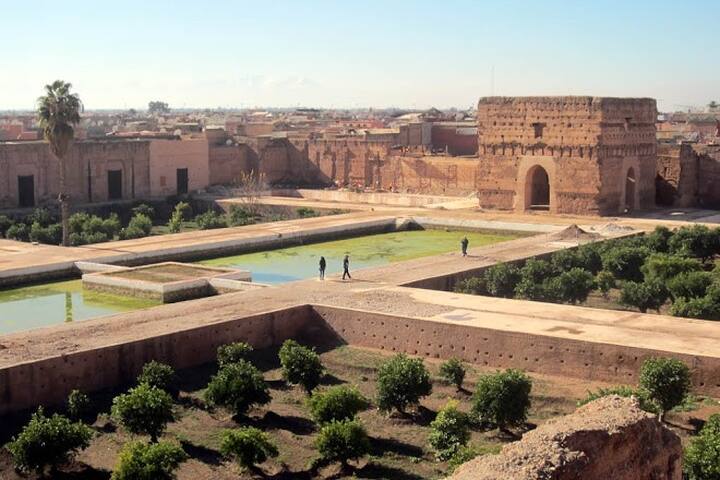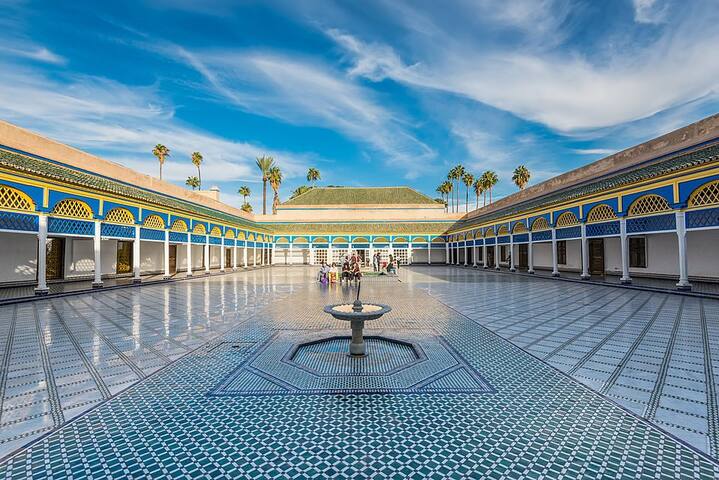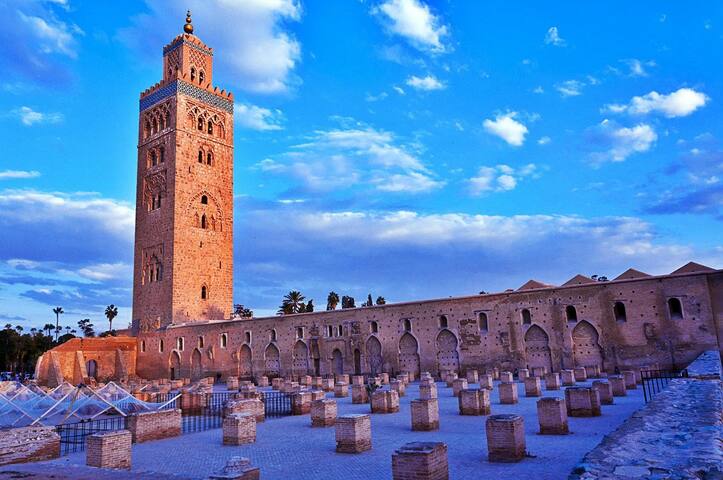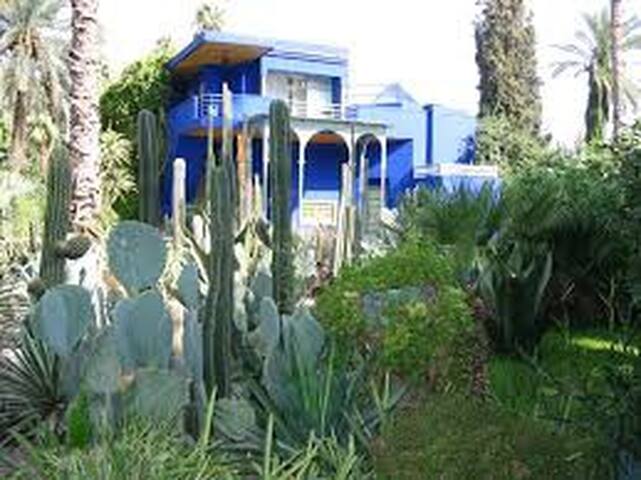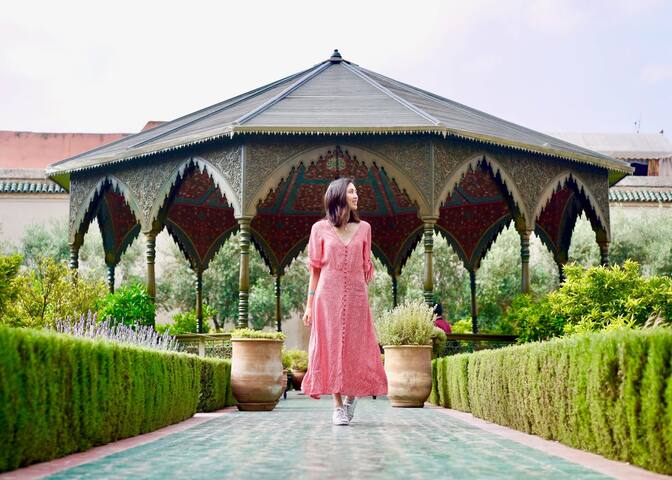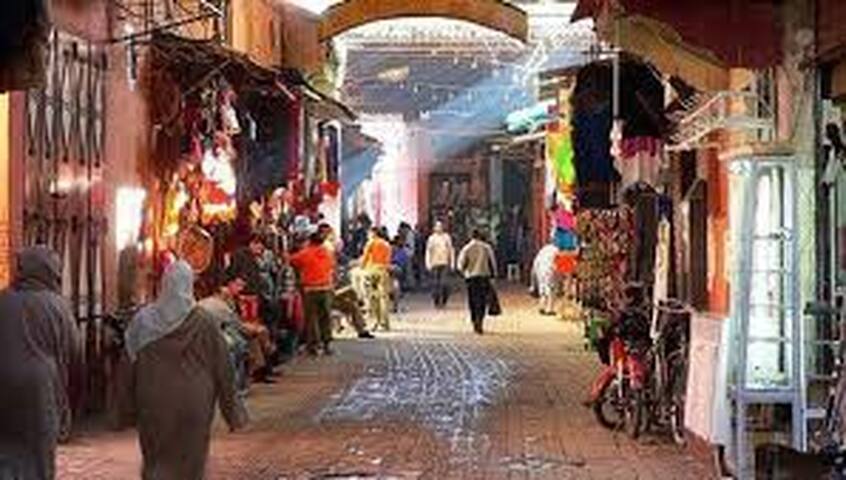Sightseeing
Jemaa el-Fna is 20 minutes walk from my place and 5-minute taxi ride that will cost you 10dh.
Think of it as live, action channel, surfing: everywhere you look in the
Jemaa el-Fna, Marrakesh’s main square, and open-air theatre, you’ll
discover drama already in progress. The hoopla and halqa (street
theatre) has been non-stop here ever since this square was the site
of public executions around AD 1050 – hence its name, which means
‘assembly of the dead’. By 10 am, the daily performance is underway.
Snake charmers blast oboes to calm hissing cobras; henna tattoo
artists beckon to passersby; water-sellers in fringed hats clang brass
cups together, hoping to drive people to drink. The show doesn’t peak
until shadows fall and 100 chefs arrive with grills in tow, cueing
musicians to tune up their instruments. This is a show you don’t want
to miss – but stay alert to horse-drawn-carriage traffic, pickpockets
and rogue gropers. Arrive early in the evening to nab prime seats on
makeshift stools (women and elders get preference). Applause and a
few dirhams ensure an encore. It's a bargain show, and critically
acclaimed too: for bringing urban legends and oral history to life
nightly, Unesco declared the Jemaa el-Fna a ‘Masterpiece of World
Heritage’ in 2001. This square is the highlight of any Marrakech night.
Musicians, dancers, and storytellers pack this square at the heart of
the medina, filling it with a cacophony of drum beats and excited shouts.
97 lokal ang nagrerekomenda
Jemaa el-Fna
Jemaa el-Fna is 20 minutes walk from my place and 5-minute taxi ride that will cost you 10dh.
Think of it as live, action channel, surfing: everywhere you look in the
Jemaa el-Fna, Marrakesh’s main square, and open-air theatre, you’ll
discover drama already in progress. The hoopla and halqa (street
theatre) has been non-stop here ever since this square was the site
of public executions around AD 1050 – hence its name, which means
‘assembly of the dead’. By 10 am, the daily performance is underway.
Snake charmers blast oboes to calm hissing cobras; henna tattoo
artists beckon to passersby; water-sellers in fringed hats clang brass
cups together, hoping to drive people to drink. The show doesn’t peak
until shadows fall and 100 chefs arrive with grills in tow, cueing
musicians to tune up their instruments. This is a show you don’t want
to miss – but stay alert to horse-drawn-carriage traffic, pickpockets
and rogue gropers. Arrive early in the evening to nab prime seats on
makeshift stools (women and elders get preference). Applause and a
few dirhams ensure an encore. It's a bargain show, and critically
acclaimed too: for bringing urban legends and oral history to life
nightly, Unesco declared the Jemaa el-Fna a ‘Masterpiece of World
Heritage’ in 2001. This square is the highlight of any Marrakech night.
Musicians, dancers, and storytellers pack this square at the heart of
the medina, filling it with a cacophony of drum beats and excited shouts.
Built at the end of XVI century, under the kingdom of the sultan
Ahmed al-Mansur Saadi, and discovered only at the beginning of the
20th century, the mausoleum hosts the bodies of the Saadians in an
ambience full of beautiful decorations made of cedar wood, marble
and Zellije (Moroccan tiles). You can recognize the different tombs of
Jews and Christians because of the presence of different markings
and symbols. The good state of preservation of the Saadian Tombs
may be attributable to the fact that they were sealed off by the sultan
Moulay Ismail. At the time, Ismail was destroying architectural gems
such as the Badi Palace, but some speculate that, when it came to
the Saadian Tombs, his superstition got the better of him and
he decided to hide rather than demolish them.
169 lokal ang nagrerekomenda
Mga Libingan ng Saadi
Rue de La KasbahBuilt at the end of XVI century, under the kingdom of the sultan
Ahmed al-Mansur Saadi, and discovered only at the beginning of the
20th century, the mausoleum hosts the bodies of the Saadians in an
ambience full of beautiful decorations made of cedar wood, marble
and Zellije (Moroccan tiles). You can recognize the different tombs of
Jews and Christians because of the presence of different markings
and symbols. The good state of preservation of the Saadian Tombs
may be attributable to the fact that they were sealed off by the sultan
Moulay Ismail. At the time, Ismail was destroying architectural gems
such as the Badi Palace, but some speculate that, when it came to
the Saadian Tombs, his superstition got the better of him and
he decided to hide rather than demolish them.
El Badi Palace, which means “The incomparable palace” was once the
magnificent royal palace of the sultan Ahmad al-Mansur of the Saadi
Dynasty. Having taken twenty five years to build, El Badi Palace was a
lavish, grand sixteenth century complex of buildings with over 350
rooms, courtyards, gardens and a huge pool. Its construction
was funded by a substantial ransom paid by the Portuguese after the
Battle of the Three Kings. Around 1700 it was stripped of its
ornamentation to furnish the palace of Alaouite Sultan Moulay Ismail
in the new capital of Meknes. Unfortunately now is in ruins and
inhabited by storks and stray cats, but the view from the terrace is still
breathless. Visitors who get in through its gatehouse can view the
remnant of much of this site. Some of the highlights include its
sunken gardens, its subterranean passages and the Koubba el
Khamsiniyya or “main hall”, which has fifty columns.
216 lokal ang nagrerekomenda
Palasyo ng El Badi
Ksibat NhassEl Badi Palace, which means “The incomparable palace” was once the
magnificent royal palace of the sultan Ahmad al-Mansur of the Saadi
Dynasty. Having taken twenty five years to build, El Badi Palace was a
lavish, grand sixteenth century complex of buildings with over 350
rooms, courtyards, gardens and a huge pool. Its construction
was funded by a substantial ransom paid by the Portuguese after the
Battle of the Three Kings. Around 1700 it was stripped of its
ornamentation to furnish the palace of Alaouite Sultan Moulay Ismail
in the new capital of Meknes. Unfortunately now is in ruins and
inhabited by storks and stray cats, but the view from the terrace is still
breathless. Visitors who get in through its gatehouse can view the
remnant of much of this site. Some of the highlights include its
sunken gardens, its subterranean passages and the Koubba el
Khamsiniyya or “main hall”, which has fifty columns.
The Bahia Palace, whose name means "The beautiful", is an ornate
and beautiful palace and a set of gardens, built in the late 19th
century, by Si Moussa, grand vizier of the sultan, for his personal use,
this palace would bear the name of one of his wives and intended to
be the greatest palace of its time. There is a 2 acre (8,000 m²) garden
with plants and flowers and 150 rooms opening onto courtyards.
Though only a portion of the palace is open to the public, you can see
the unfurnished, opulently ornamented harem that once housed Bou
Ahmed’s four wives and 24 concubines. The quarters of his favorite,
Lalla Zineb, are the most spectacular, with original woven-silk panels,
stained-glass windows, intricate marquetry and ceilings painted with
rose bouquets. Bahia’s story is an interesting one as a warlord Pasha
Glaoui claimed the palace to entertain French who were so
impressed that 3 years later, kicked out the Pasha Glaoui and turned
the palace into the home of the protectorate’s résident-généraux.
7 lokal ang nagrerekomenda
Bahia Palace - Mga Kasaysayan na Pagdalaw
Rue Riad Zitoun el JdidThe Bahia Palace, whose name means "The beautiful", is an ornate
and beautiful palace and a set of gardens, built in the late 19th
century, by Si Moussa, grand vizier of the sultan, for his personal use,
this palace would bear the name of one of his wives and intended to
be the greatest palace of its time. There is a 2 acre (8,000 m²) garden
with plants and flowers and 150 rooms opening onto courtyards.
Though only a portion of the palace is open to the public, you can see
the unfurnished, opulently ornamented harem that once housed Bou
Ahmed’s four wives and 24 concubines. The quarters of his favorite,
Lalla Zineb, are the most spectacular, with original woven-silk panels,
stained-glass windows, intricate marquetry and ceilings painted with
rose bouquets. Bahia’s story is an interesting one as a warlord Pasha
Glaoui claimed the palace to entertain French who were so
impressed that 3 years later, kicked out the Pasha Glaoui and turned
the palace into the home of the protectorate’s résident-généraux.
"You who enter my door, may your highest hopes be exceeded” reads the inscription over the entryway to the Ali ben Youssef Medersa, and after almost six centuries, the blessing still works its charms on visitors. It was founded during the period of the Merenids (14th century) by the sultan Abu al-Hassan and allied to the neighboring Ben Youssef Mosque, this Quranic learning center was once the largest in North Africa, and remains among the most splendid. The building of the madrasa was re-constructed
by the Saadian Sultan Abdallah al-Ghalib (1557–1574). In 1565 the works ordered by Abdallah al-Ghalib were finished, as confirmed by the inscription in the prayer room. Sight lines are lifted in the entry with carved Atlas cedar cupolas and mashrabiyya (wooden-lattice screen) balconies.
The medersa’s courtyard is a mind-boggling profusion of HispanoMoresque ornament: five-colour zellije (mosaic) walls, stucco archways, cedar windows with weather-worn carved vines, and a curved mihrab (eastern-facing niche) of prized, milky-white Italian Carrara marble. The carvings contain no representation of humans or animals, as required by Islam, and consist entirely of inscriptions and geometric patterns. It hosted 130 student dormitory cells cluster around the richly decorated courtyard, for a total of about 900 students. One of its best known teachers was
Mohammed al-Ifrani (1670-1745). Closed down in 1960, the building was refurbished and reopened to the public as a historical site in 1982.
273 lokal ang nagrerekomenda
Paaralan ng Anak ni Jose
Rue Assouel"You who enter my door, may your highest hopes be exceeded” reads the inscription over the entryway to the Ali ben Youssef Medersa, and after almost six centuries, the blessing still works its charms on visitors. It was founded during the period of the Merenids (14th century) by the sultan Abu al-Hassan and allied to the neighboring Ben Youssef Mosque, this Quranic learning center was once the largest in North Africa, and remains among the most splendid. The building of the madrasa was re-constructed
by the Saadian Sultan Abdallah al-Ghalib (1557–1574). In 1565 the works ordered by Abdallah al-Ghalib were finished, as confirmed by the inscription in the prayer room. Sight lines are lifted in the entry with carved Atlas cedar cupolas and mashrabiyya (wooden-lattice screen) balconies.
The medersa’s courtyard is a mind-boggling profusion of HispanoMoresque ornament: five-colour zellije (mosaic) walls, stucco archways, cedar windows with weather-worn carved vines, and a curved mihrab (eastern-facing niche) of prized, milky-white Italian Carrara marble. The carvings contain no representation of humans or animals, as required by Islam, and consist entirely of inscriptions and geometric patterns. It hosted 130 student dormitory cells cluster around the richly decorated courtyard, for a total of about 900 students. One of its best known teachers was
Mohammed al-Ifrani (1670-1745). Closed down in 1960, the building was refurbished and reopened to the public as a historical site in 1982.
It was built during the XII century by the first sovereign of the Almohads family. This minaret which is the expression of an Hispano-Moresque architecture is 77 meters tall and has 3 balls on the top which are the symbols of Water, Earth, and Fire. Five times a day, one voice rises above the Jemaa din in the adhan (call to prayer): that’s the muezzin calling the faithful from atop the Koutoubia Mosque minaret. Excavations confirm a longstanding Marrakshi legend: the original mosque built by Almoravid architects wasn’t properly aligned with Mecca, so the pious Almohads levelled it to build a realigned one. When the present mosque was finished by Sultan Yacoub el-Mansour, 100 booksellers were clustered around its base, hence the name, from kutubiyyin, or booksellers. While the Koutoubia serves a spiritual purpose, its minaret is also a point of reference for international architecture. The tower is the prototype for Seville’s La Giralda and Rabat’s La Tour Hassan, and it’s a monumental cheat sheet of Moorish ornament: scalloped keystone arches, jagged merlons (crenellations), and mathematically pleasing proportions. The minaret was sheathed in Marrakshi pink plaster, but experts opted to preserve its exposed stone in its 1990s restoration. As with most mosques in Morocco, non-Muslims are not allowed inside
118 lokal ang nagrerekomenda
Moske ng Koutoubia
Avenue Mohammed VIt was built during the XII century by the first sovereign of the Almohads family. This minaret which is the expression of an Hispano-Moresque architecture is 77 meters tall and has 3 balls on the top which are the symbols of Water, Earth, and Fire. Five times a day, one voice rises above the Jemaa din in the adhan (call to prayer): that’s the muezzin calling the faithful from atop the Koutoubia Mosque minaret. Excavations confirm a longstanding Marrakshi legend: the original mosque built by Almoravid architects wasn’t properly aligned with Mecca, so the pious Almohads levelled it to build a realigned one. When the present mosque was finished by Sultan Yacoub el-Mansour, 100 booksellers were clustered around its base, hence the name, from kutubiyyin, or booksellers. While the Koutoubia serves a spiritual purpose, its minaret is also a point of reference for international architecture. The tower is the prototype for Seville’s La Giralda and Rabat’s La Tour Hassan, and it’s a monumental cheat sheet of Moorish ornament: scalloped keystone arches, jagged merlons (crenellations), and mathematically pleasing proportions. The minaret was sheathed in Marrakshi pink plaster, but experts opted to preserve its exposed stone in its 1990s restoration. As with most mosques in Morocco, non-Muslims are not allowed inside
The subtropical Majorelle Garden is located in the heart of Gueliz,
Hivernage. It is one of the most delightful and stunning spots within
this red walled city. Although the Majorelle Garden has existed in
Morocco for decades, it was only made famous abroad when the
Majorelle Garden’s former owner and care-taker, fashion designer
Yves Saint Laurent, featured it in the 1997 Chelsea Flower Show in
London. Since this time, many have journeyed to Morocco just to
see the Majorelle Garden. The Majorelle and its buildings are
embellished by a unique shade of cobalt blue - the featured color in
the garden. The garden is 12 acres in size and radiates with
multi-colored bougainvillea, rows of bright orange nasturtiums, pink
geraniums, bold pergolas and concrete paths that exist in shades of
pastel pink, lovely lemon and apple green. With the garden there are
the over fifteen different species of birds, such as turtle doves, bulbuls
and house buntings. With its beautiful groves of bamboo, date palms
and various lily covered pools, it is little wonder why these marvelous
creatures choose Majorelle Garden as their home.
585 lokal ang nagrerekomenda
Hardin ng Majorelle
Rue Yves Saint LaurentThe subtropical Majorelle Garden is located in the heart of Gueliz,
Hivernage. It is one of the most delightful and stunning spots within
this red walled city. Although the Majorelle Garden has existed in
Morocco for decades, it was only made famous abroad when the
Majorelle Garden’s former owner and care-taker, fashion designer
Yves Saint Laurent, featured it in the 1997 Chelsea Flower Show in
London. Since this time, many have journeyed to Morocco just to
see the Majorelle Garden. The Majorelle and its buildings are
embellished by a unique shade of cobalt blue - the featured color in
the garden. The garden is 12 acres in size and radiates with
multi-colored bougainvillea, rows of bright orange nasturtiums, pink
geraniums, bold pergolas and concrete paths that exist in shades of
pastel pink, lovely lemon and apple green. With the garden there are
the over fifteen different species of birds, such as turtle doves, bulbuls
and house buntings. With its beautiful groves of bamboo, date palms
and various lily covered pools, it is little wonder why these marvelous
creatures choose Majorelle Garden as their home.
The origins of Le Jardin Secret hark back to the second half of the
sixteenth century, when the Saadian Sultan Moulay ‘Abd-Allah
commenced upon the urbanization of what is now the Mouassine
district. However, in common with many important buildings of
Marrakech, the palace, which stood on the grounds of Le Jardin
Secret, was destroyed toward the end of the seventeenth century,
after the decline of the Saadian dynasty. Towards the middle of the
nineteenth century the kaid al-Hajj Abd-Allah U-Bihi came into
possession of the land, on which, fully respecting the layout of the
Saadian era complex, a new palace was built. Marrakech enjoyed a
substantial development in this period, which favoured the
construction of gardens and rich mansions. Shortly after, the kaid
U-Bihi, who was viewed suspiciously by Sultan Muhammad IV
because suspected of power intrigues, was killed with poisoned tea.
The property then passed into the possession of the qadi Moulay
Mustapha, a great judge who enjoyed close relations with the ruling
family. In 1912, he exchanged the palace with the manor of Fez of alHajj Muhammad Loukrissi. The latter, the former head of the
watchmakers’ guild in Marrakech, had been elected in 1908 as
chamberlain of Sultan Moulay ‘Abd-al-Hafiz. When, in 1912, the Sultan
was exiled, al-Hajj Muhammad Loukrissi moved into this palace,
where he lived until 1934, the year of his death. The property then
ceased to be maintained properly, and soon fell into a state of
disrepair. The idea of restoring the building complex and opening it
to public took root in 2008, and Le Jardin Secret came into being
eight years later.
116 lokal ang nagrerekomenda
Ang Lihim na Hardin
121 Rue MouassineThe origins of Le Jardin Secret hark back to the second half of the
sixteenth century, when the Saadian Sultan Moulay ‘Abd-Allah
commenced upon the urbanization of what is now the Mouassine
district. However, in common with many important buildings of
Marrakech, the palace, which stood on the grounds of Le Jardin
Secret, was destroyed toward the end of the seventeenth century,
after the decline of the Saadian dynasty. Towards the middle of the
nineteenth century the kaid al-Hajj Abd-Allah U-Bihi came into
possession of the land, on which, fully respecting the layout of the
Saadian era complex, a new palace was built. Marrakech enjoyed a
substantial development in this period, which favoured the
construction of gardens and rich mansions. Shortly after, the kaid
U-Bihi, who was viewed suspiciously by Sultan Muhammad IV
because suspected of power intrigues, was killed with poisoned tea.
The property then passed into the possession of the qadi Moulay
Mustapha, a great judge who enjoyed close relations with the ruling
family. In 1912, he exchanged the palace with the manor of Fez of alHajj Muhammad Loukrissi. The latter, the former head of the
watchmakers’ guild in Marrakech, had been elected in 1908 as
chamberlain of Sultan Moulay ‘Abd-al-Hafiz. When, in 1912, the Sultan
was exiled, al-Hajj Muhammad Loukrissi moved into this palace,
where he lived until 1934, the year of his death. The property then
ceased to be maintained properly, and soon fell into a state of
disrepair. The idea of restoring the building complex and opening it
to public took root in 2008, and Le Jardin Secret came into being
eight years later.
The Menara gardens are gardens located to the west of Marrakech, at
the gates of the Atlas mountains. They were established in the 12th
century (c. 1130) by the Almohad ruler Abd al-Mu'min. The name
Menara derives from the pavilion with its small green pyramid roof
(menzeh). The pavilion was built during the 16th century surrounding
an artificial lake, the point of confluence of a canal system, used to
irrigate the surrounding gardens and orchards. The basin is supplied
with water thanks to an old hydraulic system which conveys water
from the mountains located approximately 30 km away from
Marrakech. The garden has a wonderfully tranquil location set amidst
olive groves and with the backdrop of the Atlas Mountains.
102 lokal ang nagrerekomenda
Mga Hardin ng Menara
The Menara gardens are gardens located to the west of Marrakech, at
the gates of the Atlas mountains. They were established in the 12th
century (c. 1130) by the Almohad ruler Abd al-Mu'min. The name
Menara derives from the pavilion with its small green pyramid roof
(menzeh). The pavilion was built during the 16th century surrounding
an artificial lake, the point of confluence of a canal system, used to
irrigate the surrounding gardens and orchards. The basin is supplied
with water thanks to an old hydraulic system which conveys water
from the mountains located approximately 30 km away from
Marrakech. The garden has a wonderfully tranquil location set amidst
olive groves and with the backdrop of the Atlas Mountains.
Founded in 1558 by Moulay Abdallah, the Mellah district was designated as
the Jewish quarter in Marrakech. At the time of the Spanish religious wars,
Jewish refugees were escaping the country, and were offered this little
piece of security by the Sultan. Morocco’s noteworthy history includes a
long period where Muslim and Jewish settlers accepted each other’s
differences and worked to bring their businesses to fruition. The Mellah in
Marrakech refers to the area where Jews resided. Living in their own
separate quarter meant that they were protected in the Kasbah walls, more
easily watched and sure enough, taxed by the government. The Jews
formed lucrative careers working as the financial representatives of bankers,
tailors, and even the jewelers of the area. Mellahs in Morocco, especially by
the mid-1500s became their own small cities, which included synagogues,
outdoor markets, fountains, and balconies overlooking the tight alleyways
and streets. If you’d like to explore the Mellah, then you can enter through
the Place des Ferblantiers, which was once referred to as the Place de
Mellah. If you are having a hard time finding the area, look for the tin
workers who now line the outer edge of the square souk. In this area, you’ll
also be able to visit Place Souweka, which is a fountain that marks the
center of the quarters. When walking through the souk, attempt to stay on
the main passageways through and you’ll come upon the Jewish Cemetery
and shrines that are still visited today. The synagogues are also along this
same route and the main ones are called the Lazama and El Fasiines. The
Mellah of Marrakech is an interesting area that tells a story of Morocco’s
past, a country that has been open to those of different cultural and ethnic
backgrounds for centuries.
30 lokal ang nagrerekomenda
Mellah
Founded in 1558 by Moulay Abdallah, the Mellah district was designated as
the Jewish quarter in Marrakech. At the time of the Spanish religious wars,
Jewish refugees were escaping the country, and were offered this little
piece of security by the Sultan. Morocco’s noteworthy history includes a
long period where Muslim and Jewish settlers accepted each other’s
differences and worked to bring their businesses to fruition. The Mellah in
Marrakech refers to the area where Jews resided. Living in their own
separate quarter meant that they were protected in the Kasbah walls, more
easily watched and sure enough, taxed by the government. The Jews
formed lucrative careers working as the financial representatives of bankers,
tailors, and even the jewelers of the area. Mellahs in Morocco, especially by
the mid-1500s became their own small cities, which included synagogues,
outdoor markets, fountains, and balconies overlooking the tight alleyways
and streets. If you’d like to explore the Mellah, then you can enter through
the Place des Ferblantiers, which was once referred to as the Place de
Mellah. If you are having a hard time finding the area, look for the tin
workers who now line the outer edge of the square souk. In this area, you’ll
also be able to visit Place Souweka, which is a fountain that marks the
center of the quarters. When walking through the souk, attempt to stay on
the main passageways through and you’ll come upon the Jewish Cemetery
and shrines that are still visited today. The synagogues are also along this
same route and the main ones are called the Lazama and El Fasiines. The
Mellah of Marrakech is an interesting area that tells a story of Morocco’s
past, a country that has been open to those of different cultural and ethnic
backgrounds for centuries.
Food scene
This labyrinth-like market is a place to wander around and let your
senses be assaulted by the sights, smells and sounds. Prepare yourself
to bargain if you feel like shopping. Marrakech is a shopper’s nirvana!
A place where some of the finest hand crafted goods won’t cost you
the earth and, to add to the paradisaical tone, you’re actively
expected to bargain, what more could one ask for? If this sounds like
your idea of consumer heaven then head direct for the souks in the
North of the Medina, where you will find different artisans fashioning
all manner of products. Some markets to look out for include the
leather market and the carpet market where you can pick-up high
quality hand-woven rugs. For sheer interest alone, and to watch
real craftsmen at work, be sure to wander through the blacksmiths’,
dyers’ and carpenters’ markets. If the bustle of the souk gets to be too
much, and you’re all bartered out, then head over to the Ville
Nouvelle where the shopping experience comes air conditioned
boutique style. Here you will find exclusive designer wear and one-off
original items, artisan and antique shops and warehouse outlets.
Medina of Marrakesh
This labyrinth-like market is a place to wander around and let your
senses be assaulted by the sights, smells and sounds. Prepare yourself
to bargain if you feel like shopping. Marrakech is a shopper’s nirvana!
A place where some of the finest hand crafted goods won’t cost you
the earth and, to add to the paradisaical tone, you’re actively
expected to bargain, what more could one ask for? If this sounds like
your idea of consumer heaven then head direct for the souks in the
North of the Medina, where you will find different artisans fashioning
all manner of products. Some markets to look out for include the
leather market and the carpet market where you can pick-up high
quality hand-woven rugs. For sheer interest alone, and to watch
real craftsmen at work, be sure to wander through the blacksmiths’,
dyers’ and carpenters’ markets. If the bustle of the souk gets to be too
much, and you’re all bartered out, then head over to the Ville
Nouvelle where the shopping experience comes air conditioned
boutique style. Here you will find exclusive designer wear and one-off
original items, artisan and antique shops and warehouse outlets.
Payo sa lungsod
Mga paraan para makatipid
Best practices to save money and have a wonderful trip
I was born and raised in Marrakech which makes me knows all Marrakech secrets and the best practices to save money and make your trip more wonderful.
Paano makapaglibot
Taxis In Marrakech
First Taxis. in Marrakech and Morocco, in general, there are two types of taxis, small that only carry Three people and they can take you anywhere in the city, big taxis can carry up to 6 people and mostly used to take you to far places out of the city. for small taxi which you will be using a lot to move around the city make sure to tell the taxi driver to turn on the counter and only pay him the price accourding to the counter. most taxis driver will tell you an upfront price 5 to 10 times of the original price. as for big taxis make sure to negotiate to price and always cut the price 50%
Mga paraan para makatipid
always negotiate and cut the price to half
in Morocco and Marrakech, when you try to buy something from the old medina always make sure to negotiate and cut the price to half if they are okay with then pay them if not just try to walk away and most of the times they will come after you to pay them the half price.
Mga paraan para makatipid
FOOD PRICES
Always ask for a menu and only pay what is on the menu. in some places where you want to buy street food there is no menu and if the price is not reasonable than make sure to negotiate. in some places they will try not to give you the menu so they can charge you more

